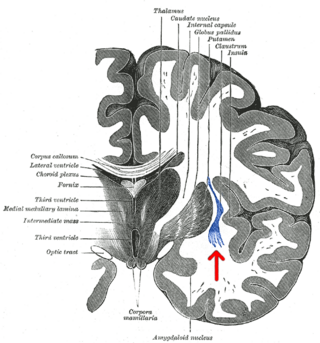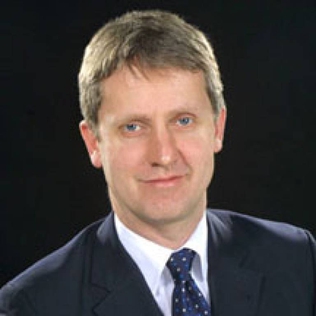The development of the nervous system, or neural development (neurodevelopment), refers to the processes that generate, shape, and reshape the nervous system of animals, from the earliest stages of embryonic development to adulthood. The field of neural development draws on both neuroscience and developmental biology to describe and provide insight into the cellular and molecular mechanisms by which complex nervous systems develop, from nematodes and fruit flies to mammals.
Computational neuroscience is a branch of neuroscience which employs mathematics, computer science, theoretical analysis and abstractions of the brain to understand the principles that govern the development, structure, physiology and cognitive abilities of the nervous system.

The neocortex, also called the neopallium, isocortex, or the six-layered cortex, is a set of layers of the mammalian cerebral cortex involved in higher-order brain functions such as sensory perception, cognition, generation of motor commands, spatial reasoning and language. The neocortex is further subdivided into the true isocortex and the proisocortex.

The claustrum is a thin sheet of neurons and supporting glial cells, that connects to the cerebral cortex and subcortical regions including the amygdala, hippocampus and thalamus of the brain. It is located between the insular cortex laterally and the putamen medially, encased by the extreme and external capsules respectively. Blood to the claustrum is supplied by the middle cerebral artery. It is considered to be the most densely connected structure in the brain, and thus hypothesized to allow for the integration of various cortical inputs such as vision, sound and touch, into one experience. Other hypotheses suggest that the claustrum plays a role in salience processing, to direct attention towards the most behaviorally relevant stimuli amongst the background noise. The claustrum is difficult to study given the limited number of individuals with claustral lesions and the poor resolution of neuroimaging.

Retinotopy is the mapping of visual input from the retina to neurons, particularly those neurons within the visual stream. For clarity, 'retinotopy' can be replaced with 'retinal mapping', and 'retinotopic' with 'retinally mapped'.
Matteo Carandini is a neuroscientist who studies the visual system. He is currently a professor at University College London, where he co-directs the Cortical Processing Laboratory with Kenneth D Harris.

Jonathon Stevens "Jon Driver" was a psychologist and neuroscientist. He was a leading figure in the study of perception, selective attention and multisensory integration in the normal and damaged human brain.
Tobias Bonhoeffer is a German-American neurobiologist. He is director of the department Synapses – Circuits – Plasticity and current managing director at the Max Planck Institute for Biological Intelligence. His father, the neurobiologist Friedrich Bonhoeffer, was director at the Max Planck Institute for Developmental Biology in Tübingen.
Richard Alan Andersen is an American neuroscientist. He is the James G. Boswell Professor of Neuroscience at the California Institute of Technology in Pasadena, California. His research focuses on visual physiology with an emphasis on translational research to humans in the field of neuroprosthetics, brain-computer interfaces, and cortical repair.

The Department of Neurobiology at Harvard Medical School is located in the Longwood Medical Area of Boston, MA. It is consistently ranked as one of the top programs in Neurobiology and behavior in the world. The Department is part of the Basic Research Program at Harvard Medical School, with research pertaining to development of the nervous system, sensory neuroscience, neurophysiology, and behavior. The Department was founded by Stephen W. Kuffler in 1966, the first department dedicated to Neurobiology in the world. The mission of the Department is “to understand the workings of the brain through basic research and to use that knowledge to work toward preventive and therapeutic methods that alleviate neurological diseases”.
The Sainsbury Wellcome Centre (SWC) is a neuroscience research institute located in London, United Kingdom. The SWC is part of University College London (UCL), but sits outside of the faculty structure. It is funded by the Gatsby Charitable Foundation and Wellcome.

Priya Rajasethupathy is a neuroscientist and assistant professor at the Rockefeller University, leading the Laboratory of Neural Dynamics and Cognition.
Tara Keck is an American-British neuroscientist and Professor of Neuroscience and Wellcome Trust Senior Research Fellow, at University College London working in the Department of Neuroscience, Physiology, and Pharmacology. She is the Vice-Dean International for the Faculty of Life Sciences. She studies experience-dependent synaptic plasticity, its effect on behaviour and how it changes during ageing and age-related diseases. She has worked in collaboration with the United Nations Population Fund on approaches for healthy ageing. Her recent work has focused on loneliness in older people, with a focus on gender. She was named a UNFPA Generations and Gender Fellow in 2022.
Kenneth D. Harris is a neuroscientist at University College London. He is most known for his contributions to the understanding of the neural code used by vast populations of neurons. Among his discoveries is the finding that populations in sensory areas of the brain also code for body movements. Harris has contributed to the development of silicon probes and most recently of Neuropixels probes. With these probes, he and his team discovered that engagement in a task activates neurons throughout the brain.
Claudia Clopath is a Professor of Computational Neuroscience at Imperial College London and research leader at the Sainsbury Wellcome Centre for Neural Circuits and Behaviour. She develops mathematical models to predict synaptic plasticity for both medical applications and the design of human-like machines.
Ilana B. Witten is an American neuroscientist and professor of psychology and neuroscience at Princeton University. Witten studies the mesolimbic pathway, with a focus on the striatal neural circuit mechanisms driving reward learning and decision making.
Jessica Cardin is an American neuroscientist who is an associate professor of neuroscience at Yale University School of Medicine. Cardin's lab studies local circuits within the primary visual cortex to understand how cellular and synaptic interactions flexibly adapt to different behavioral states and contexts to give rise to visual perceptions and drive motivated behaviors. Cardin's lab applies their knowledge of adaptive cortical circuit regulation to probe how circuit dysfunction manifests in disease models.

Carsen Stringer is an American computational neuroscientist and Group Leader at the Howard Hughes Medical Institute Janelia Research Campus. Stringer uses machine learning and deep neural networks to visualize large scale neural recordings and then probe the neural computations that give rise to visual processing in mice. Stringer has also developed several novel software packages that enable cell segmentation and robust analyses of neural recordings and mouse behavior.
Neuropixels probes are electrodes developed in 2017 to record the activity of hundreds of neurons in the brain. The probes are based on CMOS technology and have 1,000 recording sites arranged in two rows on a thin, 1-cm long shank.
Sonja Hofer is a German neuroscientist studying the neural basis of sensory perception and sensory-guided decision-making at the Sainsbury Wellcome Centre for Neural Circuits and Behaviour. Her research focuses on how the brain processes visual information, how neural networks are shaped by experience and learning, and how they integrate visual signals with other information in order to interpret the outside world and guide behaviour. She received her undergraduate degree from the Technical University of Munich, her PhD at the Max Planck Institute of Neurobiology in Martinsried, Germany, and completed a post doctorate at the University College London. After holding an Assistant Professorship at the Biozentrum University of Basel in Switzerland for five years, she now is a group leader and Professor at the Sainsbury Wellcome Centre for Neural Circuits and Behaviour since 2018.







